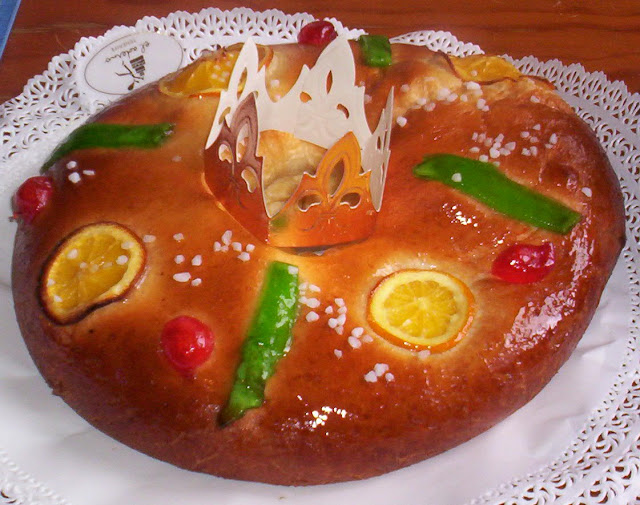 |
| Roscón de Reyes from Pasteleria El Aderno in Buenavista del Norte |
In Spain it's Epiphany, January 6th - the Feast of The Three Kings - that is the biggest day of the season's celebrations, the Three Kings having arrived, bearing gifts, on the night of January 5th. And the one indispensable item at the table is the Roscón de Reyes. It's easy to see that the Roscón, along with the French Galette des Rois, the King Cakes in Louisiana (albeit transplanted to Mardi Gras) and even the Twelfth Night cake that eventually became our Christmas Cake all developed from the same root. As Christendom spread across Europe, the cake caught on. Now you can find this formerly pagan cake on the Christmas tables of families throughout Spain, France, and Latin America!
At the Roman festivities of Saturnalia each December, the roscón, a circular cake in which a bean was hidden, was a tradition. The one who found the bean became the “king of the feast” and all those present had to obey his/her orders.
This is the same as the tradition in Tudor Christmas celebrations, where whoever received the slice of cake containing the bean was ‘crowned’ the Lord of Misrule. He was like a mock king and supervised entertainments or rather unruly events involving drinking, revelry, role reversal, and general chaos. During the medieval and Tudor periods, the Twelfth Night Cake was leavened with yeast, rather like a fruit-laden brioche - much more like the recipe for the Roscón de Reyes. The introduction of cake hoops in the late seventeenth century and the discovery during the early eighteenth century that beaten eggs could be used to raise a cake meant that the fruit breads of earlier times were replaced by a plum cake.
We later transported the bean to become the sixpence in the Christmas pudding.
Over the centuries, finding the bean in the Roscón de Reyes in Spain became "unlucky". Nowadays, the bakers will tell you that the finder just has to buy the next cake, while, the "lucky" people find either a ceramic baby Jesus. Even luckier are those who bought the Roscón de Reyes from El Aderno in Tenerife that contained a set of all three ceramic Kings, as well as the bean.
(We've published the recipe for a Roscón de Reyes and it is nowhere near as difficult as the result makes it look. You really should try it some time.)





 After more than 20 years, posts here will now only be occasional (
After more than 20 years, posts here will now only be occasional (